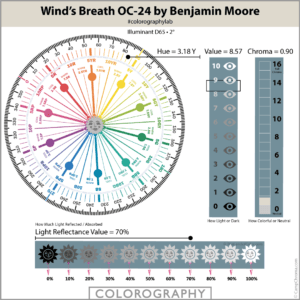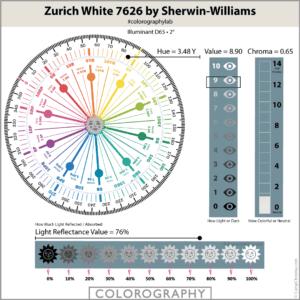Tutorial: Hue, Value, Chroma and LRV
© 2016 Lori Sawaya
HUE – One of the three dimensions of color.
Hue and color are not the same. Hue has only one dimension. Color has three dimensions: hue/value/chroma.
When you use an instrument like a spectrophotometer to measure a color, it’s the dominant wavelength in the data that the device captures that determines hue.
Our vision system translates the different wavelengths of energy it senses into categories that we’ve learned to label as red, yellow, green, blue, etc.
VALUE – tells you how light or dark a color looks. That’s why I use an eye icon in the Colorographies found in the Colorography Lab.
CHROMA – tells you how much color. Albert Munsell coined this term to organize color into strong and weak categories. Color is either strong and looks colorful or weak and looks more neutral. Click to learn more about Chroma.
LRV – is a quantity expressed in a %. Tells you how much light a color reflects and conversely absorbs.
It’s about luminance and brightness. That’s why the Colorography LRV scale is made up of sunshines.
LRV does not indicate anything about: depth, grayness, muted, vivid or dull.
Click to learn more about LRV.
UNDERSTAND THE DIFFERENCE BETWEEN VALUE AND LRV:
Unlike LRV, Value is not a measurement. It’s a judgement of how a color looks compared to a grayscale.
Here’s how it works: Value describes how the quantity of light reflected from a colored surface looks compared to light reflected by black (0%), white (100%) and various steps of neutral grays in between.
Copyright Friendly! Here's Our Policy
You may redistribute images commercial and non-commercial. Works must remain unchanged and in whole including copyright marks.




